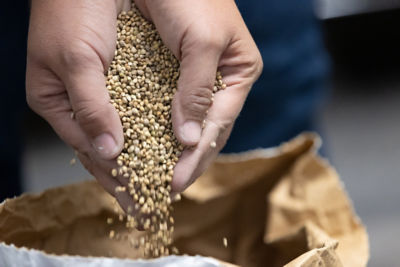Click here to download a PDF version of this spotlight
» Gray leaf spot of tomato can cause severe damage to foliage and reduce yields.
» Gray leaf spot is most prevalent in areas with warm and humid environments.
» Resistant varieties, cultural practices, and fungicides can be used to manage gray leaf spot.
Gray leaf spot is one of the most destructive diseases of tomato in areas with warm and humid conditions, such as the southeastern United States. The disease occurs in tomato growing areas of the world, primarily in tropical and subtropical regions where incidence levels as high as 80% have been observed.1,2,3,4 The disease is caused by four species of the fungal pathogen Stemphyllium, S. solani, S. lycopersici, S. botryosum, and S. vesicarium. In North America, S. solani and S. lycopersici are the most commonly occurring species.1,3 The gray leaf spot pathogens can cause disease on a range of hosts, including other solanaceous crops such as pepper, eggplant, potato, and solanaceous weed species. The pathogens can also infect crops such as spinach and cotton.2,3
SYMPTOMS
On tomato, gray leaf spot infections occur primarily on the leaflets, with some symptoms developing on petioles and stems under favorable conditions and high disease pressure. The pathogens can attack tomato leaves at all growth stages, and no symptoms occur on the fruit.1,2 Symptoms initially appear as minute brown to black specks on the lower leaf surfaces. The specks develop into lesions that are small, round to oblong, and randomly scattered on both the upper and lower leaf surfaces. The lesions become gray in the center and surrounded by brown to black margins and a yellow halo (Figure 1).5,6, 7 The lesions enlarge to 2 to 4 mm in diameter and can coalesce, resulting in large areas of necrotic tissue (Figure 2). The centers of the spots can dry out and crack. With high levels of infection, entire leaves can turn yellow, and the leaves can prematurely drop from the plants, resulting in sunscald on newly exposed fruit. Leaf drop can occur on seedlings in seedbeds without the leaf yellowing symptom.
 Figure 1. Symptoms of gray leaf spot include circular spots with gray centers and dark margins. Clemson University – USDA Cooperative Extension Slide Series, Bugwood.org.
Figure 1. Symptoms of gray leaf spot include circular spots with gray centers and dark margins. Clemson University – USDA Cooperative Extension Slide Series, Bugwood.org.
On peppers, gray leaf spot symptoms start as small (1-2 mm) reddish-brown spots on the leaves. The spots enlarge (3-5 mm), become circular to oval, and develop white centers with reddish-brown margins. As with tomato, heavily infected pepper leaves can yellow and drop prematurely. Peppers are most susceptible at the seedling stage. Lesions on stems are irregular in shape and white with red to brown margins. Lesions can weaken stems leading to breakage.8
 Figure 2. Leaf spots coalesce and form large areas of necrotic tissue. Clemson University – USDA Cooperative Extension Slide Series, Bugwood.org.
Figure 2. Leaf spots coalesce and form large areas of necrotic tissue. Clemson University – USDA Cooperative Extension Slide Series, Bugwood.org.
DISEASE CYCLE AND CONDITIONS
The fungal pathogens that cause gray leaf spot survive as saprophytes on infested plant debris and as pathogens on susceptible crop and weed plant species. The pathogens can also be seedborne.2,5,7,8 The disease is often initiated on seedlings growing in seedbeds and transplant houses. Other sources of inoculum include crop debris, volunteer tomato plants, peppers, and other hosts such as blue lupine, gladiolus, and horsenettle.1,2 The spores of the fungi are spread by wind and splashing water (rain and sprinkler irrigation). Spore germination and infection require the presence of free moisture on leaf surfaces. Disease development is favored by high humidity levels and warm temperatures (75°F to 80°F, 24°C to 27°C). The disease is most severe when conditions are humid and overcast with periods of rain or dew.1,8 Symptoms start to appear within two to five days after infection.
MANAGEMENT
The primary method for managing gray leaf spot on tomatoes is to use resistant varieties. Many commercial varieties contain the Sm gene for resistance, which was first identified on a wild species of tomato (Solanum pimpinellifolium) and introgressed into commercial tomatoes in the 1940s.2,3,9 The Sm gene is a single gene with incomplete dominance, meaning that both the male and female parent varieties need to provide the gene for the offspring to have the full level of resistance. The Sm gene coveys broad resistance to all four species of Stemphylium that cause gray leaf spot, providing near immunity to the disease. The resistance gene has been widely used since the 1940s without losing its effectiveness. Molecular markers for the gene have been identified, and these markers are used to help rapidly screen the plants resulting from crosses for the presence of the gene when new varieties are being developed.3,9 The Sm gene is not used as widely in cherry and grape tomato varieties, and the disease is more of a problem on these types of tomatoes, especially in greenhouse production systems.
Cultural management strategies include the use of diseasefree seed and transplants. Avoid infecting seedlings during transplant production by using pathogen-free potting mixes, avoiding overhead irrigation, and locating seedbeds away from production fields. Water seedlings early in the morning so that plants will dry before nightfall, and avoid watering on cloudy days. Seedlings should be inspected prior to transplanting into the field, and symptomatic plants should be removed and destroyed.2,5,8 Disinfect tools and surfaces in the greenhouse prior to starting a new crop of transplants.
Destroy crop residues promptly after harvest. Rotate fields to non-solanaceous crops for two to three years. Remove volunteer tomato plants and other solanaceous crop plants and weeds. Increase plant spacings in the field, and prune suckers in the lower canopy to promote good air circulation.2,7,8
Fungicides can be applied if necessary in seedbeds and production fields. Fungicide applications are most effective if applied at the first sign of disease in the field.1,2,8 Many fungicide products are registered for use on tomato, eggplant, and pepper to manage gray leaf spot.10 These products have pre-harvest interval (PHI) and reentry interval (RI) restrictions. Consult regional disease management guides and read current product labels when considering applying fungicides to manage gray leaf spot. Some research is being done to develop a disease forecasting model for gray leaf spot on tomato.4 The model uses data on daily temperatures, leaf wetness, and relative humidity to determine when conditions are favorable for infection. The goal is to have a model that can estimate potential disease incidence and severity levels and recommend timings for fungicide applications.
SOURCES
1 Jones, J. and Pernezny, K. 2014. Gray leaf spot. In “Compendium of tomato diseases and pests, second edition.” American Phytopathological Society, St. Paul.
2 Li, Y. 2018. Stemphylium gray leaf spot of tomato. Connecticut Agricultural Experiment Station.
3 Park, J., Kwon, S., Park, G., Lee, S., Je, B. I., and Park, Y. 2020. Host reaction of tomato varieties and applicability of Sm-linked DNA markers to Stemphylium lycopersici. Molecular Breeding 40: 106.
4 Wang, H., Antonio Sanchez-Molina, J., Li, M., and Berenguel, M. 2020. Development of an empirical tomato crop disease model: a case study on gray leaf spot. European Journal of Plant Pathology 156:477-490.
5 Melanson, R., Balbalian, C., Snyder, R., and Adams, L. 2020. Common diseases of tomatoes. Mississippi State University Extension. Publication Number: P3175.
http://extension.msstate.edu/publications/common-diseases-tomatoes.
6 Ernesto Franco, M. E., Ines Troncozo, M., Yanil Lopez, S. M., Lucentini, G., Medina, R., Nazareno Saparrat, M. C., Blanca Ronco, L., and Alberto Balatti, P. 2017b. A survey on tomato leaf grey spot in the two main production areas of Argentina led to the isolation of Stemphylium lycopersici representatives which were genetically diverse and differed in their virulence. European Journal of Plant Pathology 149:983-1000.
7 Valad, G., Messelink, G., and Smith, H. Crop protection: Pest and disease management. Page 229 in “Tomatoes, Second Edition”. Ep Heuvelink ed. CABI, Wallingford, UK.
8 Koike, S., Gladders, P., and Paulus. A. 2007. Vegetable diseases: a color handbook. Pages 211-212. Academic Press. Boston.
9 Behare J, Laterrot H, Sarfatti M, Zamir D (1991) Restriction fragment length polymorphism mapping of the Stemphylium resistance gene in tomato. Mol Plant-Microbe Interact 4:489- 492.
10 Dittmar, P., Freeman, J., Paret, M. and Smith, H. 2020. Vegetable production handbook of Florida, 2020-2021. UF IFAS Extension.
Websites verified 1-27-2021
ADDITIONAL INFORMATION
For additional agronomic information, please contact your local seed representative.
Performance may vary from location to location and from year to year, as local growing, soil and weather conditions may vary. Growers should evaluate data from multiple locations and years whenever possible and should consider the impacts of these conditions on the grower’s fields. The recommendations in this article are based upon information obtained from the cited sources and should be used as a quick reference for information about tomato production. The content of this article should not be substituted for the professional opinion of a producer, grower, agronomist, pathologist and similar professional dealing with this specific crop.
BAYER GROUP DOES NOT WARRANT THE ACCURACY OF ANY INFORMATION OR TECHNICAL ADVICE PROVIDED HEREIN AND DISCLAIMS ALL LIABILITY FOR ANY CLAIM INVOLVING SUCH INFORMATION OR ADVICE.
9068_SE_S8 Published 03-29-2021
ALWAYS READ AND FOLLOW PESTICIDE LABEL DIRECTIONS.
Bayer, Bayer Cross Design, and Seminis® are registered trademarks of Bayer Group. All other trademarks are property of their respective owners. © 2021 Bayer Group. All rights reserved.




